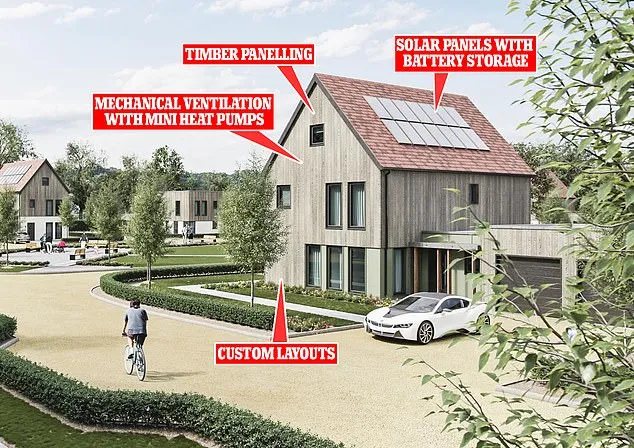The zero-carbon neighbourhood that will power itself entirely by solar: Developers create ultimate eco-houses in Oxfordshire (but they start at £1million each)
Oct 21, 2019 08:08 PM ET

Britain's ultimate zero-carbon neighbourhood is being built in Oxfordshire, with prices starting at a touch above £1million.
The eco-friendly homes are being powered solely by electricity generated from roof-fitted solar panels, with batteries to store surplus power for later use.
The properties, which are currently in the building phase, will also have mechanical ventilation and mini heat pumps to run their heating and produce hot water.
The timber-clad homes will need virtually no heating or cooling, thanks to their energy-efficient design which follows the so-called 'Passivhaus' standard.
According to developer Ssassy Property, the eco-friendly homes are around 30 years ahead of the Government’s 2050 zero-carbon target.
The company claims they are the first in the country to produce no polluting carbon dioxide at all.
Buyers can choose to customise their house's layouts, kitchens and bathrooms beyond the standard template.
Each home will be constructed from natural, sustainable materials and will come with an electric vehicle charging point.
Twenty-five of the eco-friendly homes are being constructed near the village of Southmoor, Oxfordshire, in a 7.7 acre development dubbed 'Springfield Meadows'.
Of the planned properties, eight custom-built plots have already been purchased — with the ones remaining on the market retailing for more than £1 million.
'We think this is the first development of zero-carbon, net zero-energy houses in the country,' said Ian Pritchett, director of Ssassy Property and Greencore Construction.
'Our houses are all electric and generate electricity from photovoltaic panels, which can be stored in a battery or used as it is generated.'
'We combine this with mechanical ventilation with heat recovery and mini heat pumps to generate the heating and hot water.'
The homes being built need virtually no heating or cooling as they are built to the 'Passivhaus' model — a voluntary, German-derived standard for energy efficiency.
Photovoltaic solar panels are placed on the roof to generate energy.
'Unfortunately, the Government relaxed the proposed 2016 zero-carbon targets after being lobbied by housebuilders,' added Mr Pritchett.
'At present, the main housebuilding corporations control the land and only build at the rate they are sure will sell, maintaining the UK’s housing shortage so that the normal rules of “supply and demand” don’t apply.'
'When there is a shortage of housing, buyers have to purchase what is available rather than what they might want.'
According to Mr Pritchett, current planning legislation and building regulations do not favour the construction of zero-carbon houses.
'In any sensible society, we would expect the planning system to actively encourage zero-carbon houses and be tough on anyone failing to deliver the necessary standard,' he added.
'Instead, we have a planning system that focuses other issues such as numbers of bedrooms, garden sizes, and parking places.'
'These are important issues, but they pale into insignificance compared to the catastrophic implications of climate change.'
'The planning process could be the answer to the problem if only someone had the sense to make real sustainability part of the process.'
Also read


